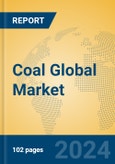- Introduction to the Coal Industry
The Russia-Ukraine conflict since 2022 has disrupted energy markets, while the EU’s “Fit for 55” proposal in July 2021 and China’s carbon neutrality goals by 2060 signal a transition away from coal. China aims to peak emissions by 2030, accelerating the phase-out of inefficient coal-fired power and optimizing consumption toward cleaner alternatives. Coal’s applications span power generation, steel production, cement manufacturing, and residential use, though its dominance is challenged by renewable energy adoption.
Market Size and Growth Forecast
The global coal market is projected to reach USD 1.45 trillion to USD 1.45 trillion by 2025, with an estimated CAGR of 0.4% to 0.6% through 2030, reflecting a maturing market amid decarbonization pressures.Regional Analysis
Asia Pacific expects a growth rate of 0.5% to 0.7%, with China and India driving demand for power and steel, though China’s green policies temper growth.Oceania anticipates 0.3% to 0.5%, with Australia’s export focus sustaining coal’s role despite domestic renewable shifts.
North America projects 0.2% to 0.4%, with the U.S. balancing coal use with clean energy investments.
Europe expects a decline of -0.5% to 0.2%, as EU policies like “Fit for 55” reduce reliance.
South America and Africa anticipate 0.1% to 0.3%, with limited growth due to infrastructure constraints.
Application Analysis
- Power Generation: Projected at 0.2% to 0.5%, dominates but faces renewable competition.
- Steel: Expected at 0.5% to 0.8%, tied to industrial growth in Asia.
- Cement: Anticipated at 0.3% to 0.6%, steady in construction-heavy regions.
- Residential & Commercial: Projected at 0.1% to 0.4%, declining due to cleaner alternatives.
Type Analysis
- Bituminous Coal: Expected at 0.4% to 0.6%, widely used in power and steel.
- Sub-Bituminous Coal: Projected at 0.3% to 0.5%, common in power generation.
- Lignite Coal: Anticipated at 0.1% to 0.3%, limited by low energy content.
- Anthracite Coal: Expected at 0.5% to 0.7%, niche high-value use in steel.
Key Market Players
- Coal India Limited: An Indian leader, Coal India dominates domestic production.
- China Shenhua: A Chinese giant, Shenhua integrates coal with energy solutions.
- Peabody: A U.S. firm, Peabody focuses on thermal coal exports.
- China Coal Group: A Chinese player, China Coal serves industrial needs.
- Shandong Energy Group: A Chinese company, Shandong expands coal output.
- Shaanxi Coal and Chemical: A Chinese firm, Shaanxi integrates coal with chemicals.
- Yankuang Energy: A Chinese leader, Yankuang focuses on coal mining.
- Jinneng Holding: A Chinese company, Jinneng serves regional energy markets.
- SUEK: A Russian firm, SUEK exports coal globally.
- Glencore: A Swiss multinational, Glencore trades coal worldwide.
- Arch: A U.S. player, Arch targets metallurgical coal.
- Shanxi Coking Coal: A Chinese firm, Shanxi specializes in coking coal.
- Bumi: An Indonesian company, Bumi exports thermal coal.
- Yangquan Coal: A Chinese player, Yangquan serves domestic needs.
- Lu’An Chemical: A Chinese firm, Lu’An integrates coal with chemicals.
Porter’s Five Forces Analysis
- Threat of New Entrants: Low. High capital and regulatory barriers limit entry.
- Threat of Substitutes: High. Renewables threaten coal’s dominance.
- Bargaining Power of Buyers: Moderate. Utilities negotiate, but supply concentration sustains pricing.
- Bargaining Power of Suppliers: High. Major producers control output.
- Competitive Rivalry: Moderate. Consolidation balances competition.
Market Opportunities and Challenges
Opportunities
- Industrial Demand: Steel and cement sustain coal use in Asia.
- Export Markets: Australia and Indonesia benefit from global trade.
- Energy Transition: Coal supports grid stability amid renewable growth.
- Technological Advances: Cleaner coal tech extends viability.
- Emerging Markets: Africa offers growth potential.
Challenges
- Decarbonization: Global policies reduce coal reliance.
- Renewable Shift: Solar and wind displace coal in power.
- Geopolitical Risks: Conflicts disrupt supply chains.
- Environmental Regulations: Stricter standards raise costs.
- Public Perception: Coal’s image hinders investment.
This product will be delivered within 1-3 business days.
Table of Contents
Chapter 1 Executive SummaryChapter 2 Abbreviation and Acronyms
Chapter 3 Preface
Chapter 4 Market Landscape
Chapter 5 Market Trend Analysis
Chapter 6 Industry Chain Analysis
Chapter 7 Latest Market Dynamics
Chapter 8 Trading Analysis
Chapter 9 Historical and Forecast Coal Market in North America (2020-2030)
Chapter 10 Historical and Forecast Coal Market in South America (2020-2030)
Chapter 11 Historical and Forecast Coal Market in Asia & Pacific (2020-2030)
Chapter 12 Historical and Forecast Coal Market in Europe (2020-2030)
Chapter 13 Historical and Forecast Coal Market in MEA (2020-2030)
Chapter 14 Summary For Global Coal Market (2020-2025)
Chapter 15 Global Coal Market Forecast (2025-2030)
Chapter 16 Analysis of Global Key Vendors
List of Tables and Figures
Companies Mentioned
- Coal India Limited
- China Shenhua
- Peabody
- China Coal Group
- Shandong Energy Group
- Shaanxi Coal and Chemical
- Yankuang Energy
- Jinneng Holding
- SUEK
- Glencore
- Arch
- Shanxi Coking Coal
- Bumi
- Yangquan Coal
- Lu'An Chemical








